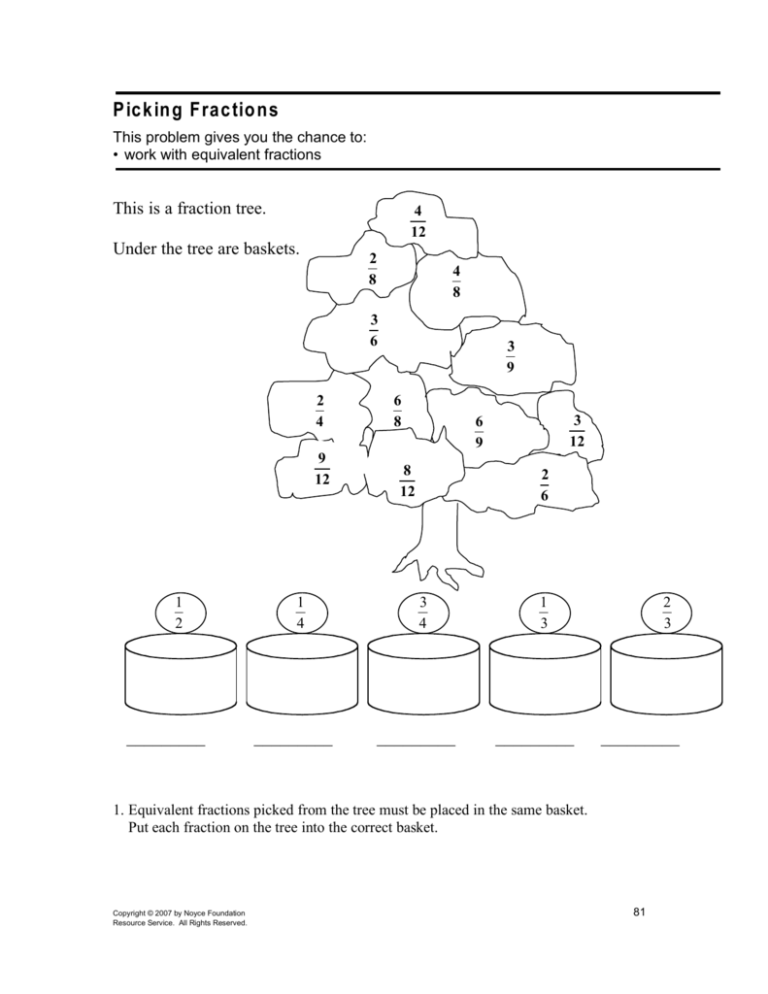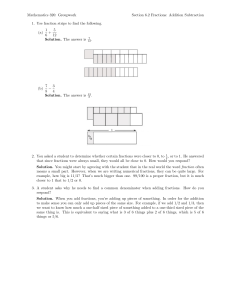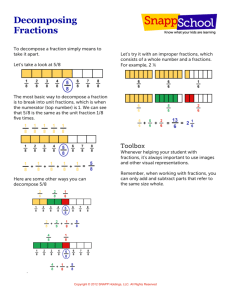
Picking Fractions
This problem gives you the chance to:
• work with equivalent fractions
This is a fraction tree.
4
12
Under the tree are baskets.
2
8
4
8
!
3
6
!
!2
4
!
1
2
!
6
8
9
12
!
!
!
!
!
2
6
!
3
4
!
_________
3
12
6
9
8
12
!
1
4
_________
3
9
!
1
3
!
_________
2
3
!
_________
_________
1. Equivalent fractions picked from the tree must be placed in the same basket.
Put each fraction on the tree into the correct basket.
Copyright © 2007 by Noyce Foundation
Resource Service. All Rights Reserved.
81
2. Find one new equivalent fraction for each basket and write it on the line that is in front
of the basket.
3. Fill in the missing numerator and denominator to make this pair of
fractions equivalent.
2
=
10
Explain how you figured it out.
8
Copyright © 2007 by Noyce Foundation
Resource Service. All Rights Reserved.
82
Task 5: Picking Fractions
Rubric
The core elements of performance required by this task are:
• work with equivalent fractions
points
section
points
Based on these, credit for specific aspects of performance should be assigned as follows
1.
Puts the fractions into the correct baskets
1/2 = 4/8, 3/6, and 2/4
1/4 = 2/8 and 3/12
3/4 = 6/8 and 9/12
1/3 = 3/9, 2/6 and 4/12
2/3 = 6/9 and 8/12
All correct 5 points
Partial credit
9, 10, 11 fractions correct 4 points:
6, 5 fractions correct 2 points:
5
8, 7 fractions correct 3 points:
4, 3 fractions correct 1 point
(4)
(3)
(2)
5
(1)
2.
Puts one more correct equivalent fraction onto each plate
All 5 correct
2
Partial credit
2-3-4 correct
(1)
2
3.
Fills in the missing values such as: denominator 5 and numerator 4
or denominator 4 and numerator 5
or denominator 2 and numerator 10
or denominator 1 and numerator 2or denominator 20 and numerator 1
and
Gives correct explanation such as: They are equivalent fractions.
1
1
8
Total Points
Copyright © 2007 by Noyce Foundation
Resource Service. All Rights Reserved.
83
Picking Fractions
Work the task. Look at the rubric. What activities and experiences have your students
had with fractions this year? What tools do you think students might have to help them
solve this task? What do you want students to know about equivalency?
Most students start their understandings of fractions with ideas about 1/2. Look at
student work for 1/2. How many students could find all the choices:____________
How many omitted 4/8_________? Omitted 3/6____________? Omitted 2/4?_________
Added extras: 4/12_______? 2/8________? 2/6________? 6/8_________?
6/9________?
How many put fractions equal to 1/2 in other spaces?
What do you think students really understand about 1/2? What are some of the things
they seem to be confused about? What are different ways that students might think about
this part of the task to get the answers?
Unit fractions seem to be the next set of fractions that make sense to students (fractions in
the form 1/denominator). Although fourths seem to be easier for students to think about
than thirds. Below is a chart on error patterns. How did your students compare?
Fraction
1/4
3/4
1/3
2/3
Omit 2/8- 22%
Error Patterns
Omit 3/12-38% 4/12 -13%
3/9- 5%
2/6- 6%
8/12 – 9%
6/8- 7%
4/8- 9%
Omit 6/8-19%
Omit 9/12-45%
8/12- 11%
4/12- 9%
3/12- 8%
6/9-9%
3/9- 8%
3/6- 6%
Omit 3/9-42%
Omit 2/6-42%
Omit 4/12-48%
6/9- 7%
9/12- 8%
8/12-7%
3/12- 8%
3/6-11%
Omit 6/9-50%
Omit 8/12-50%
9/12-12%
6/8- 8%
3/9- 8%
2/6- 15%
4/12- 11%
3/6-7%
In part 2, almost 32% did not add new fractions.
What ideas do you think students bring to the class before you begin formal instruction?
What models do you think students could make on their own to represent fractions and
show comparisons? How do you introduce fractions to the class? Are there ways to talk
about the ideas and start building understanding in discussing graphs, measurement,
Copyright © 2007 by Noyce Foundation
Resource Service. All Rights Reserved.
84
number talks throughout the year? How might these conversations facilitate learning the
more formal procedures later in the year?
Looking at Student Work on Picking Fractions
Student A is one of the few students showing work on how to check for equivalent
fractions. While the student got full marks for part 3, Student A is giving a procedure. Do
you think this method would work for other cases? Why or why not? Try it for 3/?=?/21.
Student A
Copyright © 2007 by Noyce Foundation
Resource Service. All Rights Reserved.
85
Some students attempted to use diagrams. It is difficult to draw free-hand accurately
enough to solve for all the fractions. Student B has some of the fractions correctly
identified, but shows little understanding when choosing new fractions. Only some of the
denominators are even divisible by the denominator of the original fraction. In part 3, the
student may or may not have a bit of procedural knowledge, but doesn’t even recognize
the need for a denominator under the two. What questions might you ask this student to
further probe their understanding of fractions?
Student B
Copyright © 2007 by Noyce Foundation
Resource Service. All Rights Reserved.
86
Student C also attempts to draw the fractions. Notice that 2/6 is chosen to represent both
1/3 and 2/3. 6/8 is chosen to represent 1/4 and 3/4. What do you think the student is
thinking or understanding about fractions? Where does that thinking break down? What
would be your next steps with this student?
Student C
Copyright © 2007 by Noyce Foundation
Resource Service. All Rights Reserved.
87
Student D seems to be able to think about some denominators that could yield equivalent
fractions, but struggles with how to choose a numerator. Notice the student doesn’t
recognize that 3/6= 1/2.
Student D
Copyright © 2007 by Noyce Foundation
Resource Service. All Rights Reserved.
88
Student E also has trouble with just a basic recognition of 1/2. In part 3 the student shows
confidence, but really does not seem to have a grasp of equivalency. It might be
interesting to interview this student to see what the student understands about
equivalency with number sentences. For example, how might the student fill in the
missing number in this equation: 8 + 7 = _____ + 5?
Student E
Copyright © 2007 by Noyce Foundation
Resource Service. All Rights Reserved.
89
Student F has been shown some tools to help make sense of equivalent fractions but can’t
apply them to this situation. What do you think this student understands? Is confused
about? What might be some good next steps for this student?
Student F
Copyright © 2007 by Noyce Foundation
Resource Service. All Rights Reserved.
90
Student G uses many improper fractions. This may be a partially learned procedure like
“invert and multiply” for division of fractions. Notice that the student uses 3/6 for 2/3,
not recognizing that it is one half. What are some of the common fractions that we want
students to “just know”? Also look at the explanation in part 3. This seems to be more
evidence of applying a partially learned procedure with no meaning attached.
Student G
Copyright © 2007 by Noyce Foundation
Resource Service. All Rights Reserved.
91
Student H does not think in fractional form. The student is just writing whole numbers
for the equivalents. The student is probably multiplying the numerator times the
denominator.
Student H
Copyright © 2007 by Noyce Foundation
Resource Service. All Rights Reserved.
92
4th Grade
Student Task
Core Idea 1
Number
Properties
Task 5
Picking Fractions
Work with equivalent fractions.
Develop an understanding of fractions as a part of unit whole, as part of
a collection, and as a location on a number line.
Recognize and generate equivalent forms of commonly used fractions.
Based on teacher observation, this is what fourth graders know and are able to do:
• Find equivalent fractions for 1/2
• Make equivalent fractions given just the numerator of one fraction and the
denominator of the other.
Areas of difficulties for fourth graders:
• Understanding procedures for equivalencies
• Choosing appropriate denominators
• Understanding the role of the numerator in non-unit fractions.
• Having some partially remembered procedures, but not understanding the
meaning or entire procedure
Copyright © 2007 by Noyce Foundation
Resource Service. All Rights Reserved.
93
The maximum score available for this task is 8 points.
The minimum score needed for a level 3 response, meeting standards, is 4 points.
Many students, 75%, could find 3 or 4 equivalent fractions in part 1, usually for 1/2 and 1/4.
More than half the students, 63%, could find 3 or 4 equivalent fractions and solve part 3 of the
task. A little less than half the students, 48%, could find 7 or 8 equivalent fractions and solve part
3. About 21% of the students could find most of the equivalent fractions, write their own
equivalent fractions, and solve part 3 of the task. 25% of the students scored no points on the task.
80% of the students with this score attempted the task.
Copyright © 2007 by Noyce Foundation
Resource Service. All Rights Reserved.
94
Picking Fractions
Points
Understandings
Misunderstandings
80% of the students attempted the Students had difficulty finding equivalent
0
task.
1
2
4
Students could find 3 or 4
equivalent fractions, usually
those equal to 1/2 or unit
fractions.
Students could find 3 or 4
equivalent fractions and solve
part 3 of the task.
Students could find 7 or 8
equivalent fractions and solve
part 3 of the task.
(See data in the beginning of this toolkit).
(See data in the beginning of this toolkit).
Students missed either one or two
equivalent fractions or missed part 3 of the
task.
7
8
fractions. (See data in the beginning of this
toolkit).
(See data in the beginning of this toolkit).
Students could recognize
equivalent fractions, make new
fractions that were equivalent to a
given fraction, and solve part 3 of
the task finding tow equivalent
fractions given a numerator of
one and a denominator of the
other.
Copyright © 2007 by Noyce Foundation
Resource Service. All Rights Reserved.
95
Implications for Instruction
Students need to understand the concept of equality in whole numbers and fractions. At
this grade level students should be most comfortable with unit fractions like 1/2, 1/3, and
1/4. Students should have experiences with a variety of tools such as number lines,
fraction strips, fraction circles, and bar models to help them think about equivalency or
the relative size of fractions. Students should also be introduced to procedures like
reducing fractions to find equivalent forms of the same fraction.
Students should have frequent opportunities to think about the concept fractional parts
and the quantity represented to develop and deepen these ideas over time. Routines like
number talks is one way of facilitating this discussion.
Consider making a large number line going from “0” to “1” on the board.
0
1
Write different fraction on index cards (e.g. 1/2, 1/8, 1/4, 2/3 as well as their equivalent
fractions names.
Choose only 2 or 3 fractions to work with each time you do this routine. Make multiple
copies of the same numbers. Give a card to a pair of students (so they will need to
discuss ideas / promote more discourse). Give them time to discuss where their number
would make sense on the number line.
Have one pair of students place their card where they think it belongs on the number line.
Students must give a mathematically convincing argument as to why they are placing the
number at this location.
Have the partners discuss whether they agree or disagree with the placement of the card
and why. The class may ask clarifying questions of the pair at the front of the room.
Students can then share other strategies. Leave numbers on the number line so students
can compare placement with other fractions over time.
(This routine for number talks comes from the website for San Diego School District.
Ideas for Action Research - Examining Student Justifications
Examining student work can help clarify some of the big mathematical ideas needed to
understand a concept. In this task, students are trying to make sense of equivalent
fractions and justify why this relationship is true. Look at the following examples:
• What are some of the different strategies students use to correctly find equivalent
fractions? What did the student have to understand about fractions to use this
procedure?
• Some students found equivalent fractions using procedures. Will these
procedures work for all fractions? Why do these procedures work
mathematically? Do they “make sense”?
Students at this grade level have some partial understandings about procedures or
fractions.
Copyright © 2007 by Noyce Foundation
Resource Service. All Rights Reserved.
96
•
•
•
•
Where does the thinking break down for each student?
What might be changed to make the explanation clearer?
What are next steps for different types of errors?
What kinds of discussion help students let go of misconceptions?
A powerful tool for promoting discourse in the class room is to use snippets of student
work and pose a question to get the whole class re-engaged in the mathematics of the
task. Pick 2 or 3 pieces of student work and plan your own class discussion.
Ariel
Copyright © 2007 by Noyce Foundation
Resource Service. All Rights Reserved.
97
Brianna
Clayton
Copyright © 2007 by Noyce Foundation
Resource Service. All Rights Reserved.
98
Douglas
Evita
Finn
Copyright © 2007 by Noyce Foundation
Resource Service. All Rights Reserved.
99
Georgia
Harley
Ionia
Copyright © 2007 by Noyce Foundation
Resource Service. All Rights Reserved.
100
Joshua
Kevin
Laurel
Copyright © 2007 by Noyce Foundation
Resource Service. All Rights Reserved.
101
Marcus
Nadine
Reflecting on the Results for Fourth Grade as a Whole
Think about student work through the collection of tasks and the implications for
instruction. What are some of the big misconceptions or difficulties that really hit home
for you?
_______________________________________________________________________
Copyright © 2007 by Noyce Foundation
Resource Service. All Rights Reserved.
102
If you were to describe one or two big ideas to take away and use for planning for next
year, what would they be?
_______________________________________________________________________
What are some of the qualities that you saw in good work or strategies used by good
students that you would like to help other students develop?
_______________________________________________________________________
Four areas that stood out for the Collaborative as a whole in the fourth grade were:
1. Developing Multiplicative Thinking – How do students move from thinking
about doubling as adding a number to itself to multiplying by 2? How do
students learn to think about and model multiplication and division as making
and repeating equal-size groups? How do students learn to use multiplication
as a way of describing how many times larger or how many times smaller?
2. Choosing Operations - How do we help students think about the action of an
operation?
3. Cognitive Demands of Doing It Yourself – Students need frequent operatives
to make and record their own ideas. The thinking and detail needed to make a
graph are significantly different from reading information from a graph. The
thinking and detail needed to unfold a shape, to understand the
transformations implied by a line of symmetry, is significantly different from
drawing a line through a design. Understanding equivalency enough to
generate a fraction equal to a given fraction is very different than picking from
a list.
Making Comparisons about Data – Students need opportunities not only to read data, but
they need opportunities to think about significant features: shape of data, range,
frequency and mode. Students need to develop the logic of making good comparisons
about data: What is the same and why is that significant? What is different and why is
that significant? They need to look at comparisons and discuss what makes it worthwhile
and how it could be improved.
Copyright © 2007 by Noyce Foundation
Resource Service. All Rights Reserved.
103





